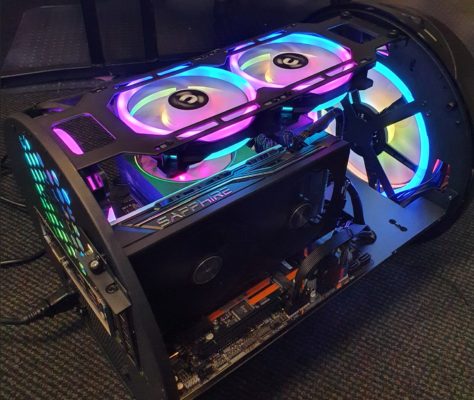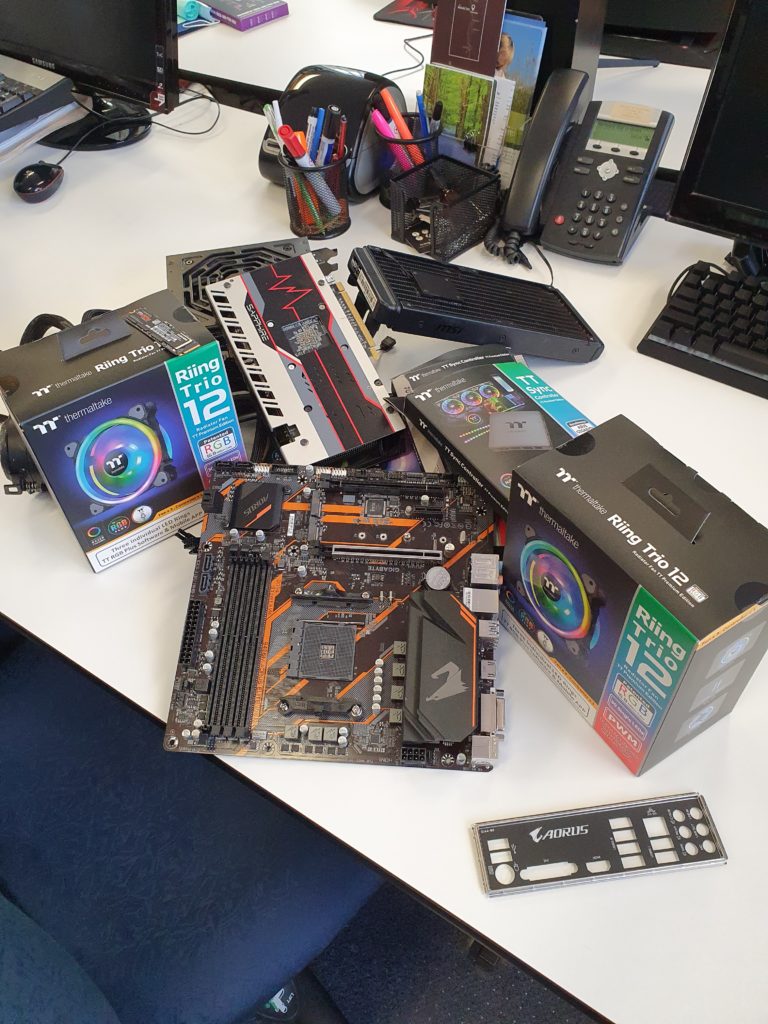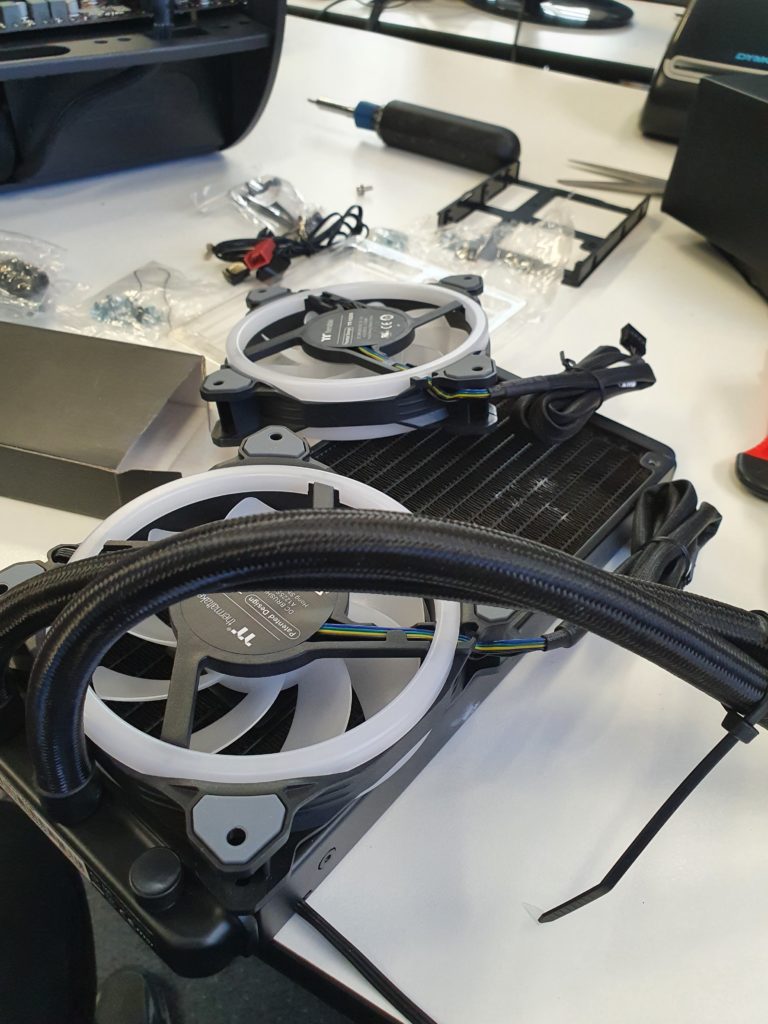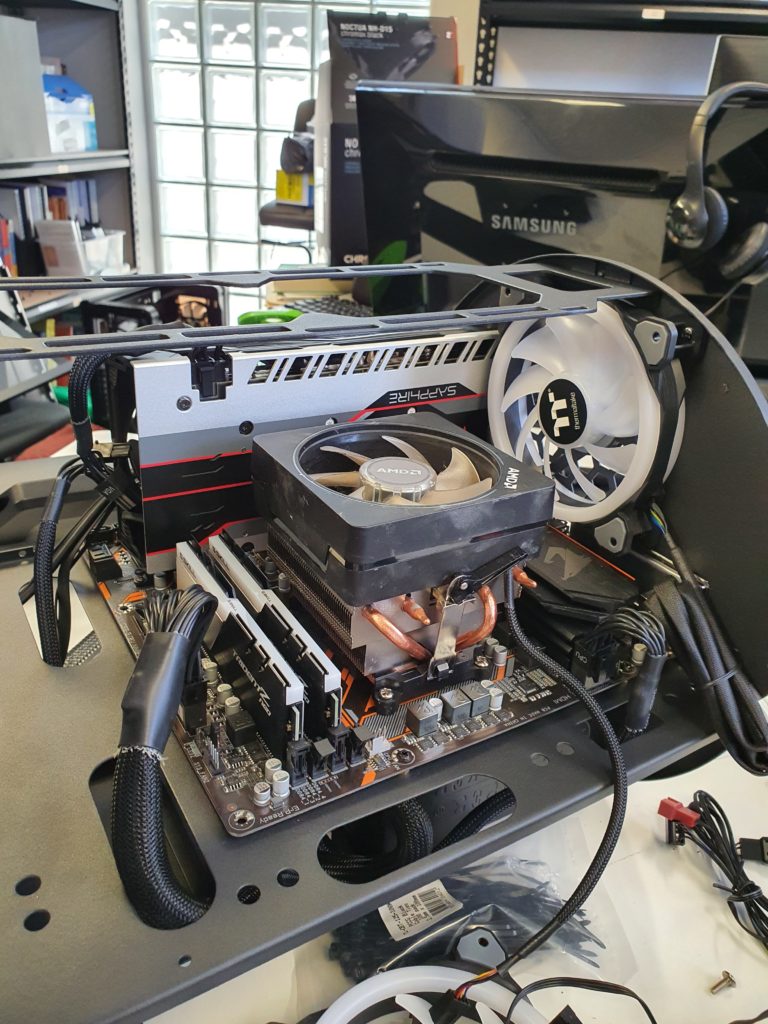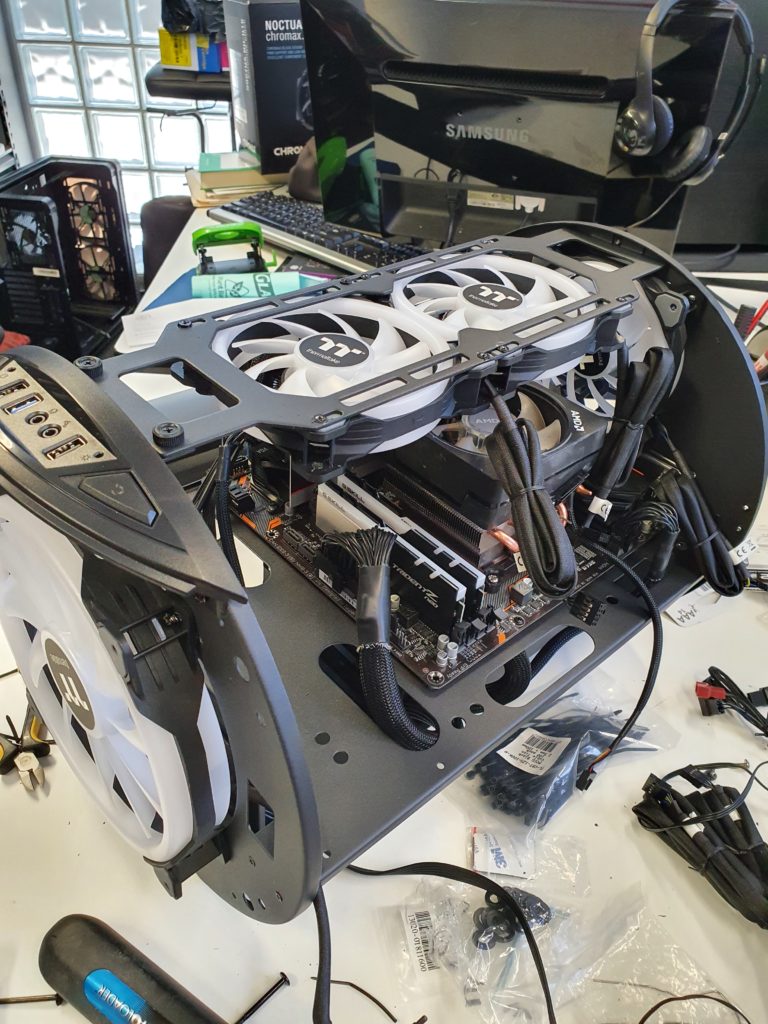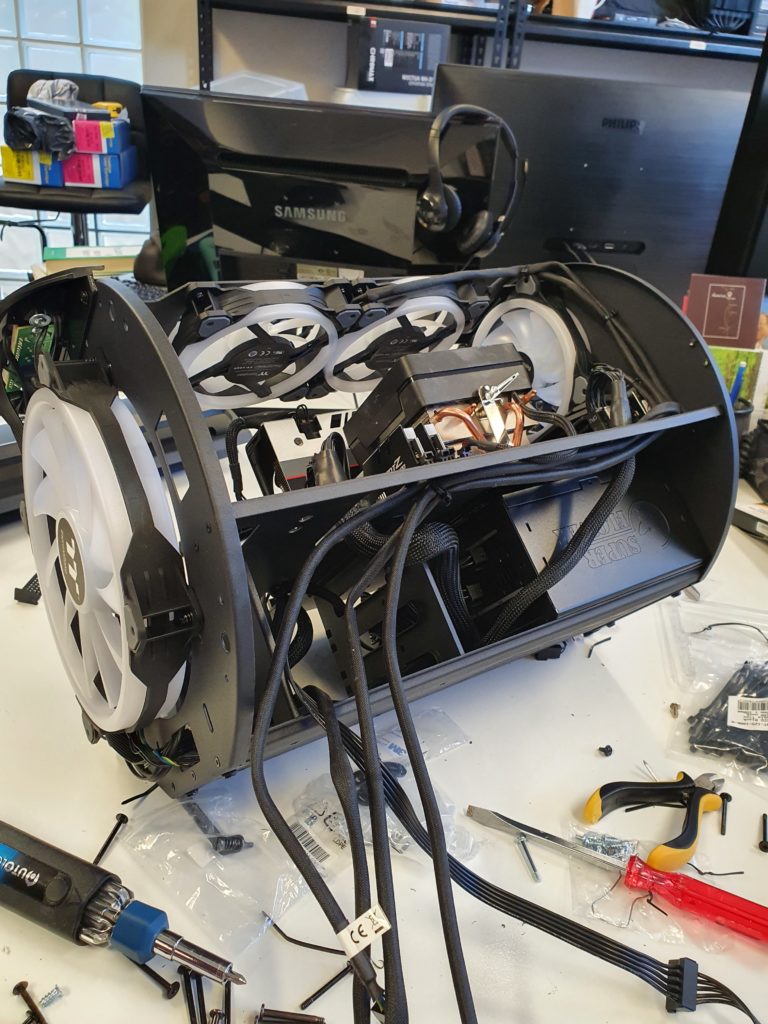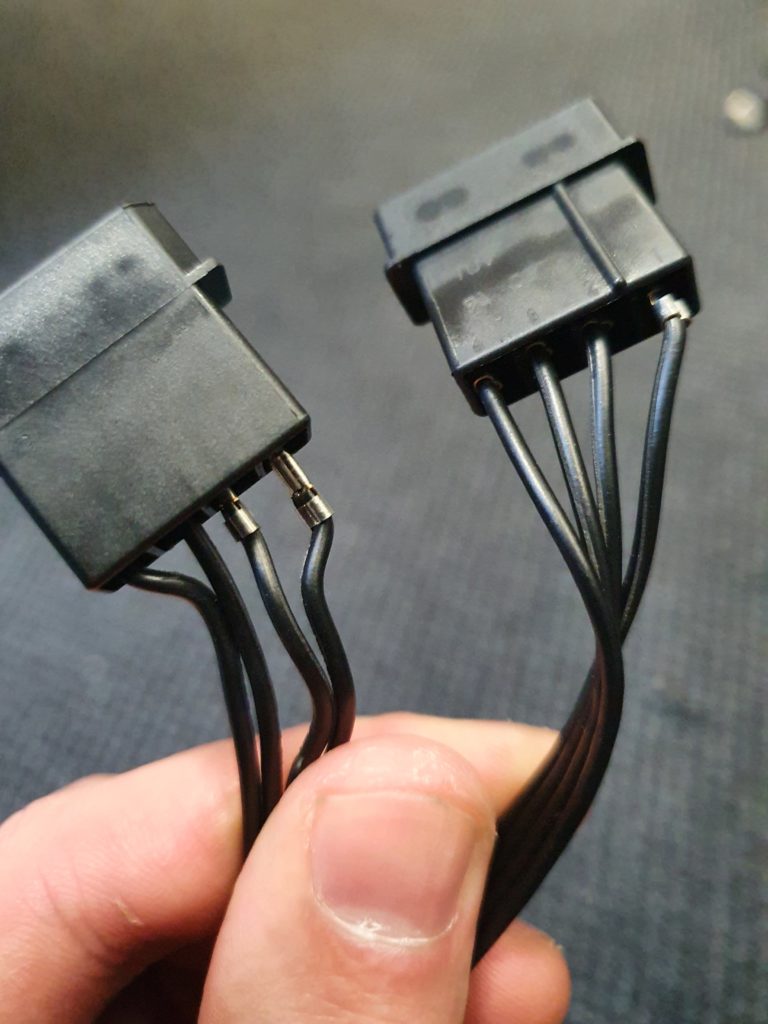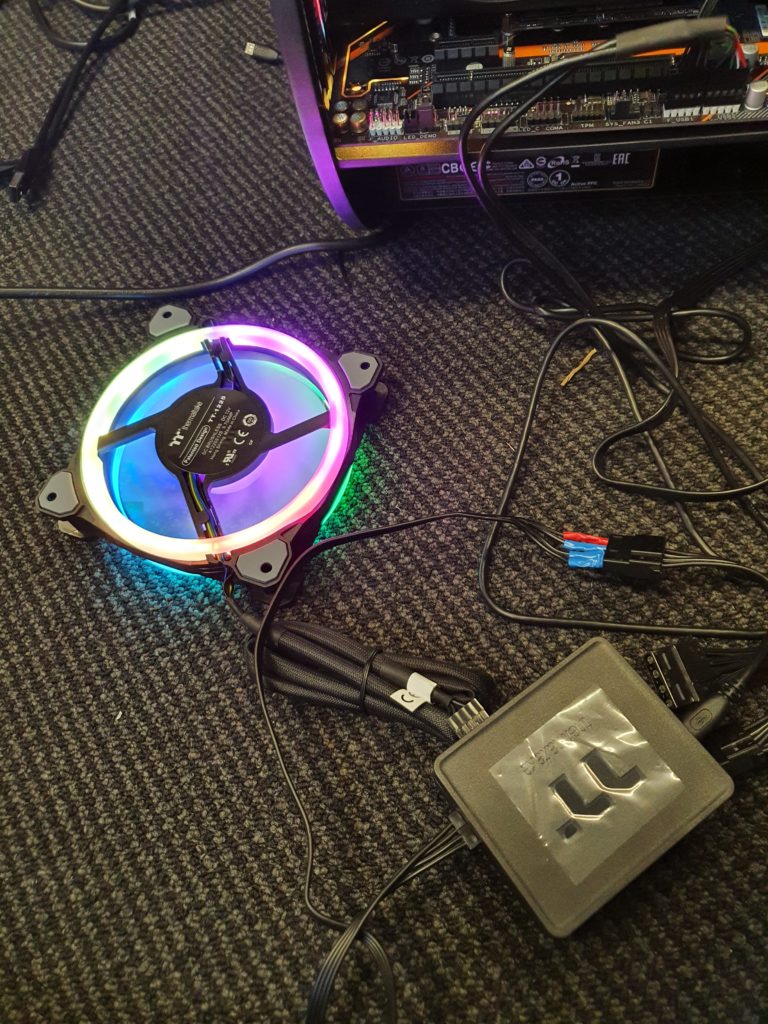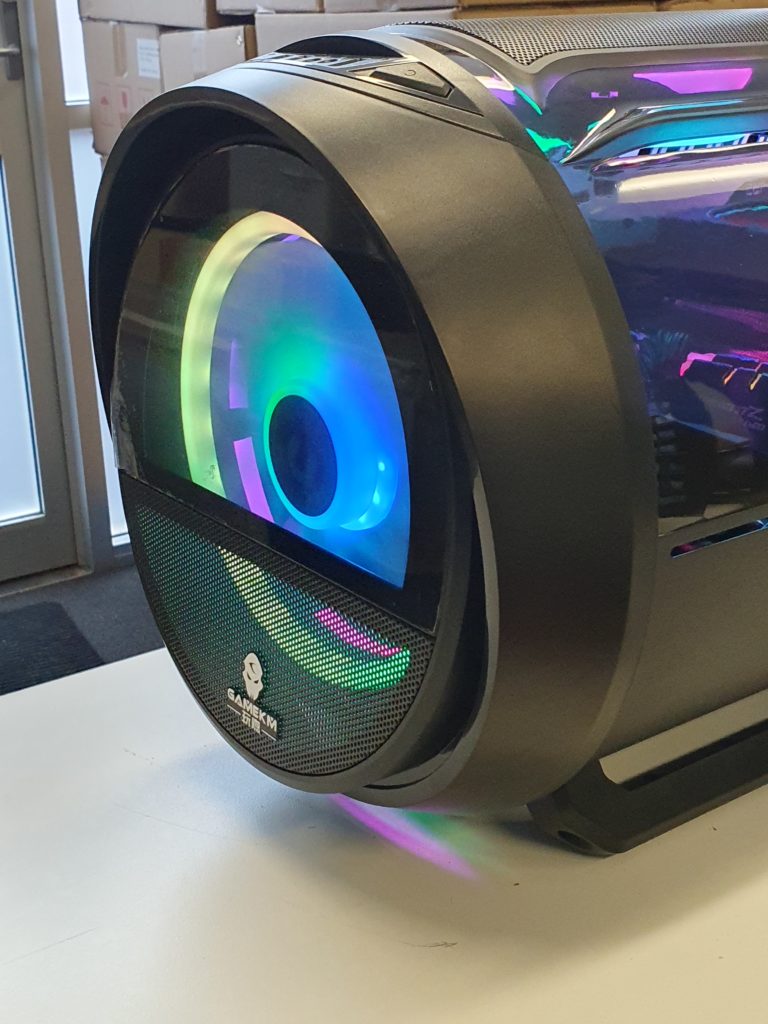I think about this image a lot.[1]I do not.

What’s the purpose of the cubes? If they’re blocks in a building, the “intelligent” worker has made his cube useless. He’s going to look like a dumbass when he arrives at the construction site and they say “wow, look at the huge brain on you. We can’t use it. It’s useless.” He should have carved his cube into a cylinder. That way he can roll it on his side, but it can still be used as a load-bearing element.
Speaking of cylinders, and rolling, and uselessness…
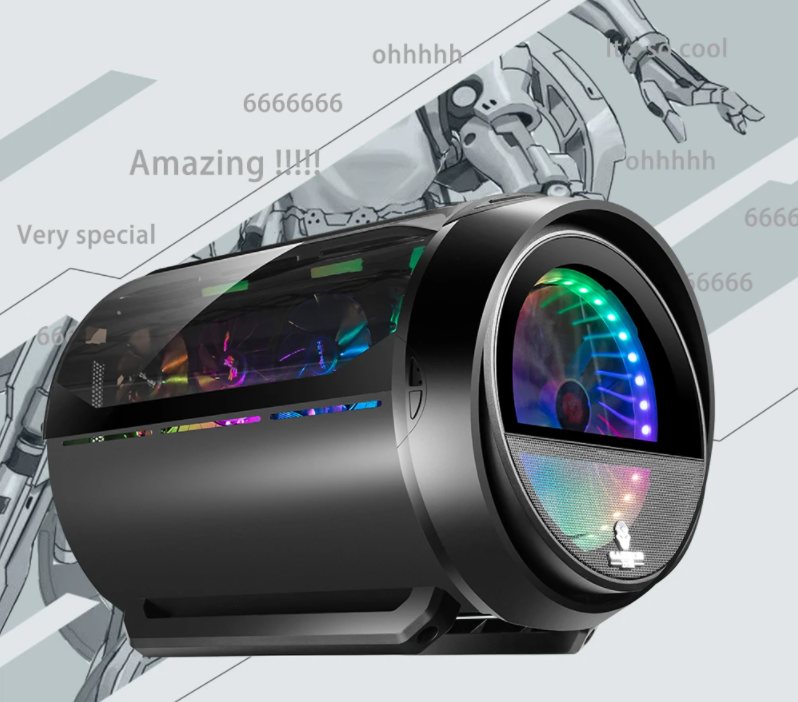
It’s my latest acquisition: a PC case from the wilderness of AliExpress.
This case is advertised around the internet under a half-dozen different names: the GAMEKM Spirit, the GAMEKM Genki Bomb, the TGEARS GAMEKM Genki Bomb Cyclops, the Space Capsule, the JF-TVQJ, and a different company called Vetroo sells an unbranded variant called the V2. I don’t know if they have the rights to the design or if heft-spelled-with-a-t is going on.
It’s clearly intended for Asian teenagers who want a cool-looking PC that doesn’t take up space. Other companies have repeatedly failed to bring cylindrical case designs to market, mostly because they made your computer look like a literal trash can. The GAMEKM SpiritGenkiBombCyclopsJFCapsuleV2 is a different story: it sits on its side (supported by two sled mounts), and its 180 degree acrylic panel (and a 200mm front-mounted fan) encourage you to stuff it with RGB rainbow puke.
This case would be right at home at a Chinese wangba or Korean PC bang: GAMEKM/Vetroo should have made a prebuilt with the latest cheats, hacks, and scripts installed. Do I have to come up with all the good ideas around here?
I didn’t add the “Amazing !!!!!” and “666666”s and so forth, those were on the marketing copy, which is full of lies.
– there is no tempered glass on the case. All transparent elements are acrylic sheet.
– There is no way in fuck you will fit a 165mm CPU cooler in this case. There might be that much internal clearance with a motherboard and CPU installed, but the top of the case is curved. If your cooler is 120mm wide, its height must be approximately √(315^2-120^2)/2 = 145.5mm to fit[2]In more detail, slice out a cross-section of the case and you have a circle with radius = 157.5mm. What’s the longest 120mm-wide rectangle you can fit in this space? Put another way, the … Continue reading Remember that you also need fans.
– it ships with a 200mm fan, but it can’t be connected to AuraSync, RGB fusion, and so on. It’s two pin Molex.
– A fan mounted in the position would draw air in to the case, not expel it as the arrows indicate.
– “vertical installation” of the GPU: technically true, but only because your motherboard is flat. You literally just put your GPU in the way you normally would. There’s no other way to install it and I have no idea why they advertised this like it’s a special feature.
– I hope “450*3158*350mm” is a mistake.
– “This little guy can make you a star in your circle of friends”. Very questionable.
It’s “fruity and small”, though. I’ll give them that.
Anyway, let’s build.
* * *
PC builds have a way of going to hell. I can’t count the times my “this will take 2 hours and then I’ll be done” plan has become “this took 8 hours and there’s a gun in my mouth”. This was one of those times.
(Images can be expanded by clicking on them)
My parts were:
- Gigabyte B550M Aorus Elite AM4 mATX Motherboard
- Ryzen 5 3600 CPU
- AMD Radeon RX 570 (cringe)
- MSI MAG CoreLiquid 240R AIO
- 500GB Samsung 970 NVME m.2 drive
- 2×16 3600MHz GSkill DDR4
- Super Flower modular PSU, not sure on wattage
- 6x Thermaltake Riing Trio 120mm fans
- 1x Thermaltake Riing Trio 200mm fan (replacing the stock GAMEKM fan)
Things started well. I removed the acrylic panel and the two sleds, installed the modular power supply, and routed the cables through the grommets. I’m trying to get things as close to their final configuration as possible – my 24 pin exits near my motherboard’s power socket, and my EPS and VGA connectors terminate near my CPU and GPU power. There are things that are easy when you have an empty case but nearly impossible when the case is full.
I also replaced the 200mm fan, which did not spark joy, with a superior Thermaltake Riing Trio 20. I needed motherboard connectivity. Also, I liked the outer circle on the Riing model fans. They also have a light diffuser bar that smears out the LED hotspots, avoiding the annoying “Christmas lights” effect of many cheap RGB fans.
The chassis is made of SPCC cold-rolled steel. It feels good to touch. There’s something about the tactility of curved metal that goes away when you have straight lines.
Next I installed the motherboard, and then the NVME drive (many of these components, by the way, came from a previous PC.) Wanna know an ancient Chinese secret? Only screw in one of your motherboard standoff screws while you’re working on it. That way your motherboard can bend and flex, allowing you to thread small cables underneath it.
My original intent was to water cool the PC. As the ad copy observes in bastard English, the top of the case supports “cold rows” (liquid cooling, presumably) of 240mm in length. By chance, I had a 240mm radiator I wasn’t using. I had a brilliant idea. I would put two 120mm TT Riing fans on both sides of the radiator block, in push-pull configuration, and mount the entire thing to the top. I’d never seen anyone do anything like that before. I’d make a radiator sandwich!
However, often there’s a reason why nobody’s done something before. Immediately, I ran into three problems. The TT Riing Trio fans are extremely thick, and none of the screws I possessed could reach through to the radiator thread (which was annoyingly deep-sunk).
I prised off the rubber pads at the corner of each fan, thinking that this would give me enough clearance. But I soon realized that having screwing two layers of fans onto a fairly thick radiator would make an absolutely massive brick, extending down far into the case. This would impact thermal performance, and additionally block the view (thus largely defeating the purpose of the Genki’s design).
I might still have gone ahead with it…but then I tried to mount the AIO pump to the AM4 bracket, and one of the retention screw literally snapped. I checked for replacements. There were none.
At this point, I abandoned the entire idea of water cooling, grabbed a crappy AMD fan I had lying around, clipped it on, and plugged it into my CPU_OPT.
I put two ThermalTake Riing Trios on the top, sans radiator. An exhaust design wouldn’t have made sense given the downdraft fan two inches underneath them, so I turned them into intakes blowing additional air into the case. The Genki thingo has slots cut into the side so that air can escape. The third Riing Trio went on the back.
Here we were:
Note the scratched paint on the fan bracket. I was already running out of patience, and slapping things together.
Next, I took the fan cables and very carefully escorted them down into the basement of the case, using zipties to keep them tight. That’s not the only way to combine basements and zipties.
Notice the empty cavity where my hard drives are supposed to go. I have no external HDs, NVME makes them obsolete. I’m reclaiming the space to store cables and other crap.
I turned the computer on and it POSTed. By this point, we were 95% done. I just had to connect the fan cables into the included Thermaltake controller. What could go wrong with such a simple procedure?
I plugged my 20mm fan into port 1 and 2 (it uses two!), my three Riing Trios into ports 3, 4, and 5, and turned the PC on.
The fans didn’t spin. I assumed that there was some driver issue with the controller and USB link into the motherboard…but my computer identified that there was a controller attached. The fans just wasn’t receiving any power. Curious.
I tried several different things (different fans, different motherboard headers, etc). Eventually, I discovered the culprit: Molex cables, and the fact that they are dogshit.
Molex is a cabling standard invented by a company from the 30s that used to make flower pots (I’m not kidding. Look it up.). Although they technically carry more power than the competing SATA standard, they are far easier to break, as they rely on just four crimped or soldered points of failure. I don’t know why Thermaltake expects me to power any device in 2021 with Molex. Probably someone has a spreadsheet showing that updating to SATA power would drop their MMR by 0.4% this quarter and cause the planet to explode and Hitler to come back to life. I don’t know.
Here’s what happened: the female Molex on my PSU had slightly bent pins.
When I plugged the controller in, the misaligned rings failed to accept the +5v and +12v metal prongs, and literally pushed them out of their housing. I destroyed two Molex cables by plugging them in!
This wasn’t good. I could only use my fans if the controllers had power. And the controllers no longer had a way of receiving power.
Lacking a crimping kit and also lacking tolerance, I did the laziest and most dangerous thing possible: I pulled all of the prongs out of my ruined Molex housing, wrapped them in 400v electrical tape, and shoved them individually into the female Molex.

This seemed to work.
I stuck both my controllers (each set of Riing Trio Plus fans came with one) together with double-sided tape, and stored them directly next to the motherboard. This wasn’t my original plan, but if anything explodes or catches fire thanks to my disastrous solution, at least I’ll be the first to know about it. I might fix this long term. Or I might continue to do nothing.
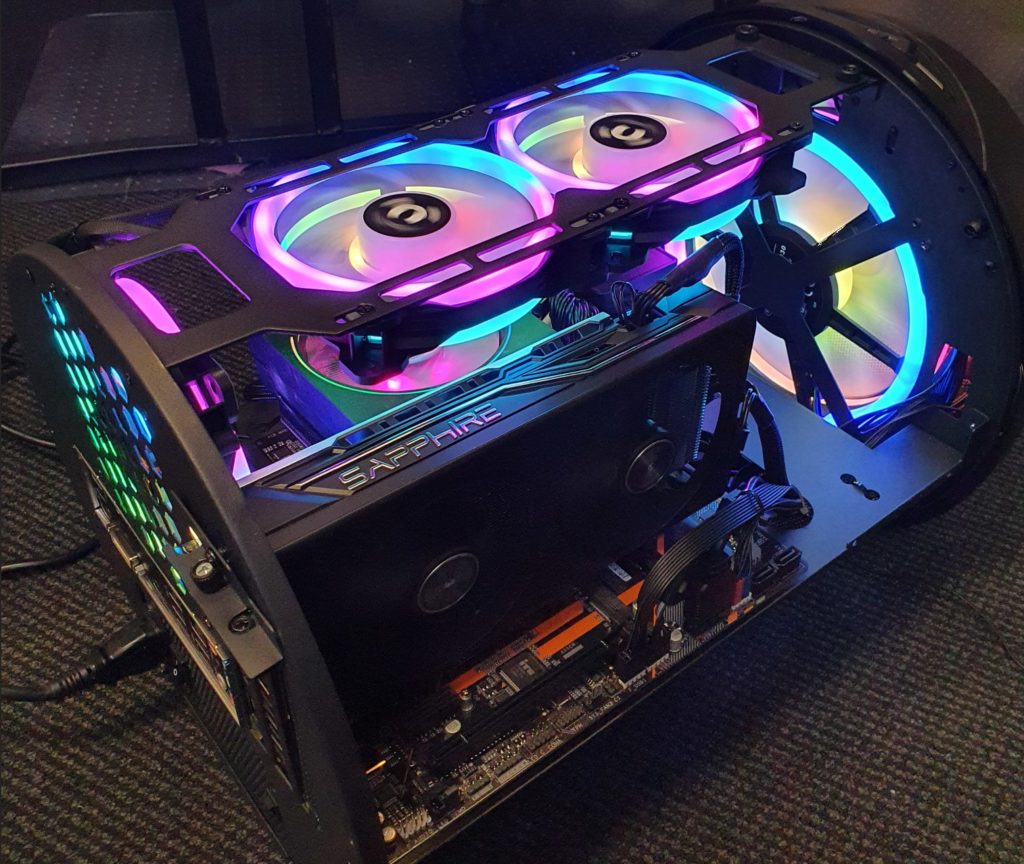
Everything is now ready to go, and I’m typing using this machine now.
It has unimpressive specs, high noise, high heat, and has a questionable upgrade path. I like it a lot.
With builds, my goal is generally to equal or surpass the test build they used to advertise it. I think I did it with this one. Notice how they have an ugly run of cabling over the exhaust fan? Not on mine.
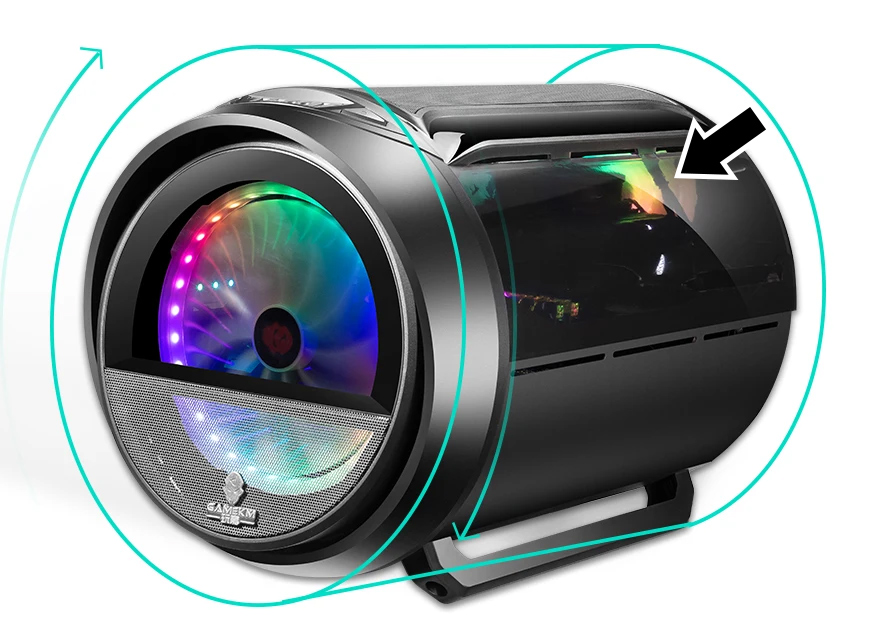
The case’s name has probably changed six times since I wrote this, so I think I’ll give it one of my own: POLYPHEMUS.
“He [Odysseus] then sailed for the land of the Kyklopes (Cyclopes), and put to shore. He left the other ships at the neighbouring island, took one in to the land of the Kyklopes, and went ashore with twelve companions. Not far from the sea was a cave, which he entered with a flask of wine given him by Maron. It was the cave of a son of Poseidon and a nymphe named Thoosa, an enormous man-eating wild man named Polyphemos (Polyphemus), who had one eye in his forehead. When they had made a fire and sacrificed some kids, they sat down to dine; but the Kyklops (Cyclops) came, and, after driving his flock inside, he barred the entrance with a great rock. When he saw the men, he ate some.
Odysseus gave him some of Maron’s wine to drink. He drank and demanded more, and after drinking that, asked Odysseus his name. When Odysseus said that he was called Nobody, the Kyklops promised that he would eat Nobody last, after the others: this was his act of friendship in return for the wine. The wine them put him to sleep.
Odysseus found a club lying in the cave, which with the help of four comrades he sharpened to a point; he then heated it in the fire and blinded the Kyklops. Polyphemos cried out for help to the neighbouring Kyklopes, who came and asked who was injuring him. When he replied ‘Nobody!’ they assumed he meant no one was hurting him, so they went away again. As the flock went out as usual to forage for food, he opened the cave and stood at the entrance with his arms spread out, and he groped at the sheep with his hands. But Odysseus bound three rams together . . . Hiding himself under the belly of the largest one, he rode out with the flock. Then he untied his comrades from the sheep, drove the flock to the ship, and as they were sailing off he shouted to the Kyklops that it was Odysseus who had escaped through his fingers.
The Kyklops had received a prophecy from a seer that he would be blinded by Odysseus, and when he now heard the name, he tore loose rocks which he hurled into the sea, just missing the ship. And from that time forward Poseidon was angry at Odysseus.”[3]POLYPHEMUS & ODYSSEUS. Pseudo-Apollodorus, Bibliotheca E7. 3 – 9 (trans. Aldrich) (Greek mythographer C2nd A.D.) :
The gematric and symbolistic parallelism of the tale is hard to ignore. I am Odysseus. Wine represents time: the computer drank all I could give it, and still demanded more. Fire represents electricity: it attracted the giant, but eventually destroyed the giant. I grew tired of the beast’s threats, hardened a spear in the flame, and drove it directly into the 200mm cyclops eye, “blinding it” by destroying the Molex controller cable.
Like Odysseus, I then engineered an embarassing but effective solution to escaping the blinded beast’s clutches. I am now sailing away, and although the beast throws rocks, I will surely prevail.
Polyphemus is a Romanisation of the Ancient Greek Πολύφημος (Polúphēmos). More specifically, πολύ (polú) + φήμη (phḗmē) + -ος (-os), literally “many-voiced”, “much spoken of”. This could be broadly interpreted as “many-titled”, or a reference to the fact that it has so many different names.
This case and I were destined to meet, just as I was destined to slay it. Poseidon’s angry with me, though. Not sure how I’ll get out of that one. But for now, I have Polyphemus.
References
| ↑1 | I do not. |
|---|---|
| ↑2 | In more detail, slice out a cross-section of the case and you have a circle with radius = 157.5mm. What’s the longest 120mm-wide rectangle you can fit in this space? Put another way, the rectangle has vertices ABCD. If AB = 120, what’s BC?
The trick is that the rectangle’s diagonal measurement (AC) is the same as the enclosing circle’s diameter, so AC = r*2 = 315mm. Treating this diagonal as a triangle’s hypotenuse, Pythagoras’s Theorem (BC^2 = AC^2 – AB^2) tells us that side BC is √(315^2=99,225-120^2=14,400) = 291mm. Since the available area is a semicircle, the measurement is 145.5mm. I’ve cheated a little: the motherboard isn’t located precisely at the 50% line on the circle, but it’s close – particularly since you will also want fans installed on the top. This method can, of course, be adapted to other cooler sizes like 90mm and 140mm. |
| ↑3 | POLYPHEMUS & ODYSSEUS. Pseudo-Apollodorus, Bibliotheca E7. 3 – 9 (trans. Aldrich) (Greek mythographer C2nd A.D.) : |
No Comments »
Comments are moderated and may take up to 24 hours to appear.
No comments yet.

